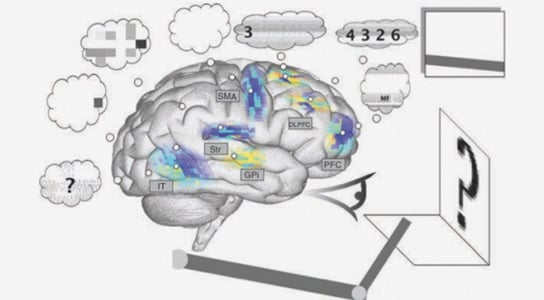
A screen capture from a simulation movie of Spaun in action shows the input image on the right. The output is drawn on the surface below Spaun’s arm. Neuron activity is approximately mapped to relevant cortical areas and shown in color (red is high activity, blue is low). Credit: Image by Chris Eliasmith
The Semantic Pointer Architecture Unified Network (Spaun) was created by theoretical neuroscientists to simulate complex behavior from fewer neurons.
The scientists published their findings in the journal Science. Spaun contains 2.5 million simulated neurons, which is a lot fewer than the 86 billion that the average human has, but enough to recognize lists of numbers, do simple arithmetic and solve reasoning problems.
Spaun was created by Chris Eliasmith, a theoretical neuroscientist at the University of Waterloo, in Canada, and his colleagues. “Throwing a lot of neurons together and hoping something interesting emerges doesn’t seem like a plausible way of understanding something as sophisticated as the brain,” states Eliasmith.
“Until now, the race was who could get a human-sized brain simulation running, regardless of what behaviors and functions such simulation exhibits,” says Eugene Izhikevich, chairman of the Brain Corporation in San Diego, California. Now, neuroscientists will focus on getting the most biological functions and animal-like behaviors out of their simulated neurons.
Spaun simulates the physiology of each of its neurons from spikes of electricity that flow through them to neurotransmitters that cross between them. The computing cells are divided into groups, which correspond to specific parts of the brain. The simulated parts include parts of the brain that process images, control movements and store short-term memories. These regions are wired together and respond to inputs in a way that mimics the action of neurotransmitters.
Spaun can perform at least eight different tasks, from copying an image to finding the next number in a series. When it is completed, it writes out the answer with a physically modeled arm. Spaun is almost as accurate at simple tasks as the average human, and reproduces some of the quirks of human behavior, such as the tendency of remembering items at the start and end of a list better than those in the middle.
Spaun provides a powerful platform to test hypotheses about how the brain works. It even has a virtual basal ganglia region, an area that acts like a switchboard, allowing the brain to toggle between different behaviors.
If parts of the model are destroyed, the researchers can see what behaviors might fail. The scientists have already submitted a paper in which they killed off Spaun’s virtual neurons at the same rate as those in an aging brain, seeing the same cognitive decline.
Spaun has some limits. It simulates only a fraction of the full brain and cannot learn completely new tasks or deal with inputs beyond ten numerals and a few symbols. It is also slow in computing terms, taking hours to simulate one second of neural behavior.
Reference: “A Large-Scale Model of the Functioning Brain” by Chris Eliasmith, Terrence C. Stewart, Xuan Choo, Trevor Bekolay, Travis DeWolf, Yichuan Tang and Daniel Rasmussen, 30 November 2012, Science.
DOI: 10.1126/science.1225266









Be the first to comment on "Simulated Brain Performs Well at Simple Tasks"